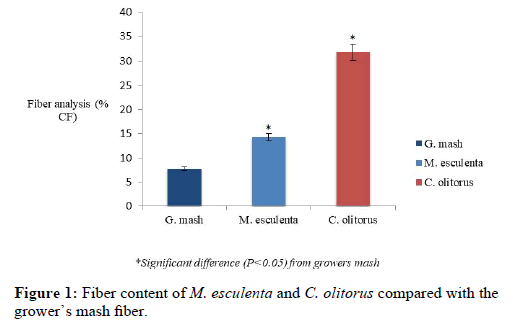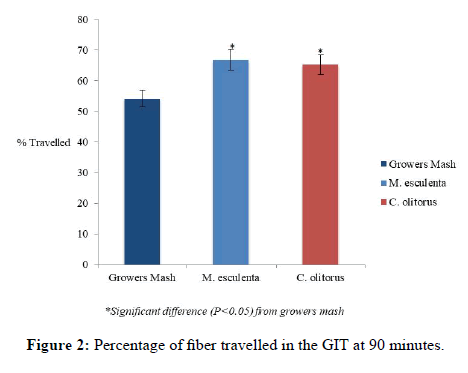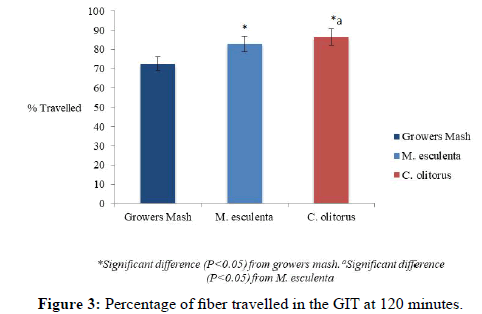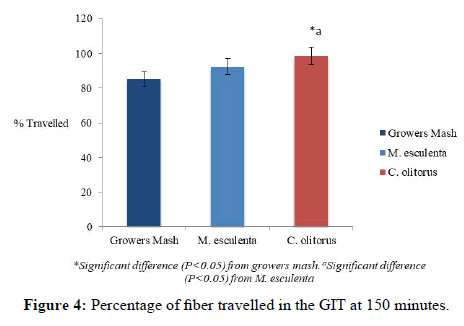Advantage of Corchorus olitorus on Intestinal Transit Time over Manihot esculenta in Female Wistar Rats
2 Department of Physiology, University of Benin, Benin, Nigeria
Citation: Ige SF, et al. Advantage of Corchorus olitorus on Intestinal Transit Time over Manihot esculenta in Female Wistar Rats. Ann Med Health Sci Res. 2018;8:1-4
This open-access article is distributed under the terms of the Creative Commons Attribution Non-Commercial License (CC BY-NC) (http://creativecommons.org/licenses/by-nc/4.0/), which permits reuse, distribution and reproduction of the article, provided that the original work is properly cited and the reuse is restricted to noncommercial purposes. For commercial reuse, contact reprints@pulsus.com
Abstract
Since fiber is widely known to decrease Intestinal Transit Time (ITT), we sought to understand the relative effect of fiber of Corchorus olitorus on ITT over that of Manihot esculenta in female wistar rats. 27 animals weighing 100-130g were randomly divided into three groups of 9 rats each. While group 1 was fed grower’s mash (GM) (normal feed diet), groups 2 and 3 were fed crude fibers of Manihot esculenta (ME) and Corchorus olitorus (CO) respectively. Crude fibers were extracted from GM, CO and ME using standard procedures. ITT was determined by measuring the intestinal length covered by the feeds at 90, 120 and 150 minutes postprandial and was expressed in percentage of the total length of the small intestine. When compared with GM fed group, there was an increase in % intestinal length covered in CO and ME fed rats 90 minutes postprandial. At 90 minutes postprandial, there was no significant change in % intestinal length covered in CO fed rats when compared with rats given ME. At 120 minutes postprandial, ME and CO fed rats showed increased % intestinal length covered when compared with GM fed rats. CO fed rats showed a higher % intestinal length covered than ME fed rats. Furthermore, At 150 minutes postprandial, CO and ME fed rats exhibited higher % intestinal length covered than GM fed rats. However, CO consumption resulted in increased % intestinal length covered than ME. Hence, we conclude that ingestion of fibers of CO decreased ITT than that of ME.
Keywords
Crude fibers; Corchorus olitorus; Manihot esculenta; Postprandial; Intestinal transit time
Introduction
Dietary fiber (DF), one of the components of foods, consists of arabinoxylans, cellulose and plant components such as lignin, inulin, chitins, pectins, beta-glucans, and oligosaccharides. [1] It is present naturally in a variety of foodstuffs including grains and their by-products, oil seeds, fruits and vegetables and supplemented to others. [2]
Although, fibers are resistant to digestion and absorption in the digestive tract in human small intestine, [3] they undergo complete or partial fermentation in the large intestine resulting in decreased low density lipoprotein, low risk of atherosclerosis and reduction in gastrointestinal transit time. [4]
Gastrointestinal transit time is the interval between consumption of food and it’s elimination as feces. It is a handy indicator of digestive health, and by extension, overall health status. For example, Simpson and Campbell [5] claimed that some soluble fibers may block intestinal mucosal adherence and translocation of potentially pathogenic bacteria resulting in modulation of intestinal inflammation. Also, a population of women with higher ingestion of fibers had lower interlukin-6 and tissue necrotic factor (TNF-α-R2). [6]
Furthermore, study has revealed that the physical nature and type of foods determine the rate of intestinal digestion, absorption and transit. [4] For instance, foods containing insoluble fibers were shown to demonstrate the tendency to increase bulk, soften stool and shorten transit time through intestinal tract. [4] Bond and Levitt, [7] showed that small bowel transit time of wheat bran was greater than that of lactulose.
Corchorus olitorus (popularly known as Ewedu in Yoruba Language) and Manihot esculenta (cassava) are major staple food in developing countries. Works have shown that these plant-borne foods play a beneficial role in gastrointestinal health. [8,9] However, it is unclear whether the crude fiber of Corchorus olitorus decreases intestinal transit time than that of Manihot esculenta. Therefore; the aim of the study is to investigate the relative effect of crude fiber of Corchorus olitorus on intestinal transit time over that of Manihot esculenta in female wistar rats.
Materials and Methods
Site of the experiment
This study was conducted in the animal house of the Department of Physiology LAUTECH, Ogbomoso, Nigeria.
Animal care and management
Twenty seven adult female wistar rats weighing 100-130 g were used for the research work. They were divided into three groups consisting of nine animals each. These rats were kept in three different cages with a wire mesh covering. They were fed pelletized grower’s mash ad libitum, provided water through drinking trough and kept under 12 hour light and 12 hour darkness at room temperature.
Ethical certification
The study was conducted in line with the guidelines of United State National Institute of Health (NIH) Guidelines for the use of laboratory rats.
Collection and extraction of fiber materials
The stem of Corchorus olitorus and root of Manihot esculenta were purchased at a local Market in Ogbomoso, Oyo State, Nigeria.
The Manihot esculenta tuber and Corchorus olitorus stem were peeled and washed respectively. They were soaked in warm water for five (5) days. On the fifth day, the fiber was removed and air dried for seven (7) days. On the seventh day, the fiber was blended into small particles according to the method of Nwoke et al. [10]
Fiber determination
Fiber determination of the selected fibers was carried out at Animal Production and Health Department, Federeal University of technology Akure (FUTA), Nigeria, using the standard method of AOAC. [11]
Percent Crude fibre (% CF):

Where,
W1 = Weight of the sample (g),
W2 = Weight of crucible and residue after drying (g), and
W3 = Weight of crucible and residue after incineration (g).
Test meals preparation
10 g of the extracted fiber was mixed with 1gram of eosin dye to form pellets.
Experimental procedure
The experimental animals were weighed and randomly grouped into:
Group 1: Administered normal feed diet (Grower’s mash).
Group 2: Administered test meal containing Manihot esculenta fiber
Group 3: Administered test meal containing Corchorus olitorus fiber.
The animals were fasted for 12 hours before the onset of the experiment after which they were then weighed and fed with the prepared test meal.
After feeding, the animals were returned into their cages and given water ad libitum. Three animals were then sacrificed per each group at 90 minutes, 120 minutes and 150 minutes by cervical dislocation. The animals were immediately dissected, their abdominal cavity was opened and the distance travelled by the test meal in the intestine was measured. [12] The length of the small intestine was measured from the pyloric sphincter to the appendix.
The transit time was then expressed as a percentage of the small intestinal tract travelled. The formula is as follow:

Statistical analysis
Data are analyzed using SPSS using Analysis of Variance (ANOVA). Pairwise comparisons were done using Least Square Difference at P<0.05.
Results
The figure shows that Corchorus olitorus fiber is significantly more compared to fiber of Maniot esculenta and the growers mash [Figure 1].
At 90 minutes, there was a significant increase in the percentage travelled by Manihot esculenta and Corchorus olitorus compared to grower’s mash used in control animals (p<0.05). There was no significant difference in the percentage travelled of Manihot esculenta when compared with that of Corchorus olitorus in the experimental rats in 90 minutes (p>0.05) [Figure 2].
At 120minutes, there was a significant increase in the percentage travelled of Manihot esculenta and Corchorus olitorus compared to grower’s mash used in control animals (p<0.05). There was also significant increase in the percentage travelled of Corchorus olitorus when compared with that of Manihot esculenta in the experimental rats in 120 minutes (p<0.05) [Figure 3].
At 150 minutes, there was a significant increase in the percentage travelled of Corchorus olitorus compared to grower’s mash used in control animals (p<0.05). There was also a significant increase in the percentage travelled of Manihot esculenta compared to grower’s mash used in control animals (p>0.05). When compared with fiber of Manihot esculenta, there was a significant increase in the percentage travelled of Corchorus olitorus in the experimental rats (p<0.05) [Figure 4].
Discussion
Studies have documented the advantages of consuming dietary fiber. These include production of healthful compounds through fermentation process, increase in bulk, softening of stool and shortening of transit time through the intestinal tract. [4,13,14] This research work investigated the relative effect of crude fiber of Manihot esculenta over Corchorus olitorius on intestinal transit time using female wistar rats as a model.
Analysis of crude fiber content of Manihot esculenta and that of Corchorus olitorius (Figure 1) showed that the latter contained more fiber than Manihot esculenta and grower mash respectively and that Manihot esculenta contained more fiber than grower mash. Therefore, the significant increases in % intestinal length covered in rats that ingested Manihot esculenta fibers when compared with those that consumed fiber of grower mash postprandial was due to the high fiber content in Manihot esculenta. Apart from the fact that crude fiber (Weende Cellulose) is a part of insoluble fiber, [15] foods containing high insoluble fiber are known to exhibit short intestinal transit time with high fecal volume and suppressed fat absorption. [4,14,16] In this study, we also observed that there was a significant increase in % intestinal length covered in Manihot esculenta fed rats when compared with grower mash fed rats 150 minutes postprandial.
Consumption of Corchorus olitorius 90, 120 and 150 minutes postprandial increased % intestinal length covered when compared with grower mash fed group. This was also due to the high crude fiber content of Corchorus olitorius. The short transit time associated with high fiber containing foods has been linked to low risk of colorectal cancer and diverticulosis, increased growth of colonocytes and protection of gastrointestinal mucosa. [8]
Conclusion
Although, at 90 minutes postprandial, there was no significant change in % intestinal length covered when compared with rats given Manihot esculenta, intake of Corchorus olitorius caused an increase in % intestinal length covered 120 and 150 minutes postprandial when compared with group fed Manihot esculenta. This indicates that crude fiber of Corchorus olitorus exhibits a shorter intestinal transit time than that of Manihot esculenta. This result suggests that consumption of crude fiber of Corchorus olitorus (Ewedu) may improve gastrointestinal health by lowering the risk of constipation and fecal impaction than that of Manihot esculenta (Cassava).
In conclusion, the findings of this study show that intake of Corchorus olitorus decreased intestinal transit time than Manihot esculenta.
Conflicts of Interest
All authors disclose that there was no conflict of interest.
REFERENCES
- Anderson JW, Baird P, Davis RH, Ferreri S, Knudtson M, Koraym A, et al. Health benefits of dietary fiber. Nutrition reviews. 2009;67:188-205.
- USDA. National Nutrient Database, US Department of Agriculture, Standard Release 28. 2015.
- Yates AA. Establishing new principles for nutrient reference values (NRVs) for food labeling purposes. Nutrition research and practice. 2007;1:89-93.
- Mudgil D, Barak S. Composition, properties and health benefits of indigestible carbohydrate polymers as dietary fiber: a review. International journal of biological macromolecules. 2013;61:1-6.
- Simpson HL, Campbell BJ. Dietary fibre–microbiota interactions. Alimentary Pharmacology & Therapeutics. 2015;42:158-179.
- Ma Y, Hébert HR, Li W, Bertone-Johnson ER, Olendzki B, Pagoto SL et al. Association between dietary fiber and markers of systemic inflammation in the Women's Health Initiative Observational Study. Nutrition. 2008;24:941-949.
- Bond JH, Levitt MD. Effect of dietary fiber on intestinal gas production and small bowel transit time in man. Am J Clin Nutr 1978;31:10.
- Al Batran R, Al-Bayaty F, Ameen Abdulla M, Al-Obaidi J, Mazen M, Hajrezaei M, et al. Gastroprotective effects of Corchorus olitorius leaf extract against ethanol-induced gastric mucosal hemorrhagic lesions in rats. J Gastroenterol Hepatol. 2013;28:1321-1329.
- Bahekar SE, Kale RS. Antidiarrheal activity of ethanolic extract of Manihot esculenta Crantz leaves in Wistar rats. J Ayurveda Integr Med. 2015;6:35-40.
- Kyrian Uchenna N, Godswill Nweze K, Izuchukwu Charles I. Effects of the methanolic extract of Abeloschus esculentus (L) Moench (Okro) Fruit on the testes and sperm characteristics of male albino wistar rats. International Journal of Advanced Biological and Biomedical Research. 2014;2:2686-2690.
- AOAC. Methods of Analysis of Association of Official Analytical chemists (16th ed). Washington DC, USA. 1997;1:600-792.
- Enck P, Merlin V, Erckenbrecht JF, Wienbeck M. Stress effects on gastrointestinal transit in the rat. Gut. 1989;30:455-459.
- Staniforth DH, Baird IM, Fowler J, Lister RE. The effects of dietary fibre on upper and lower gastro-intestinal transit times and faecal bulking. Journal of International Medical Research. 1991;19:228-233.
- Munakata A, Iwane S, Todate M, Nakaji S, Sugawara K. Effects of dietary fiber on gastrointestinal transit time, fecal properties and fat absorption in rats. The Tohoku Journal of Experimental Medicine. 1995;176:227-238.
- Dhingra D, Michael M, Rajput H, Patil RT. Dietary fibre in foods: A review. J Food Sci Technol, 2012;49:255-266.
- Gallaher, Daniel D. Dietary fiber. Washington, D.C., USA: ILSI Press. 2006;102-110.








 The Annals of Medical and Health Sciences Research is a monthly multidisciplinary medical journal.
The Annals of Medical and Health Sciences Research is a monthly multidisciplinary medical journal.